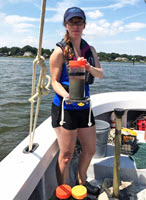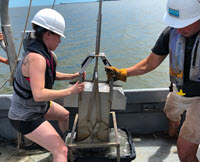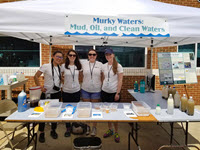
Oil that enters a marine environment can attach to particulate matter suspended in the water and form oil particle aggregates, which then sink to the seafloor. Some oil particle aggregates are created when microbial excretions cause particulate matter and oil to cluster and bind together, forming Marine Oil Snow or MOS. Others result when fine sediment particles adhere to oil without microbial involvement, forming oil sediment aggregates or OSAs. Following Deepwater Horizon, there was a large Marine Oil Snow Sedimentation and Flocculent Accumulation (MOSSFA) event that transported oil to the seafloor, impacting the benthic ecosystem. If an oil spill were to occur in shallower shelf waters where more sediment is suspended in the water column, OSAs would likely play an important role in transporting oil to the seafloor.
Danielle Tarpley is implementing and modifying code that calculates particle aggregation for the Coupled Ocean-Atmosphere-Wave and Sediment Transport (COAWST) numerical model, helping improve predictions about vertical oil transport via flocculated mud particles, or mud flocs. Simulations from this model will help improve overall estimations of oil fate by predicting the amount and location of sinking OSAs.
Danielle is a Ph.D. student with the Virginia Institute of Marine Science’s Department of Physical Sciences and a GoMRI Scholar with the Consortium for Simulation of Oil-Microbial Interactions in the Ocean (CSOMIO).
Her Path

In her early high school years, Danielle whizzed through her math classes. Hoping to advance her education, she enrolled at a math and science school for her junior and senior years and took a marine biology class that sparked her scientific curiosity. That experience motivated her to enter the marine science undergraduate program at Coastal Carolina University, which required students to study marine biology, geology, chemistry, and physical oceanography and helped her discover an affinity for the physical sciences. Later, she completed a master’s degree there in coastal marine and wetland studies, which included analyzing observational data using numerical model results.
When Danielle began her Ph.D. studies at the Virginia Institute of Marine Science (VIMS), she started working with the COAWST model to study the transport of mud flocs. There, she joined Dr. Courtney Harris’s Sediment Transport Modeling lab, which became part of a GoMRI-funded CSOMIO research team, developing a model framework describing oil transport. The oil transport model will account for biological and particulate interactions with hydrocarbons in the ocean. Danielle’s CSOMIO research adapts the flocculation model to account for the transport of settling oil within particle aggregates. “I find science challenging, like a puzzle – if the pieces are put together properly, then you can answer questions. It’s very satisfying when the pieces fall into place, because my curiosity has an answer as well as more questions,” said Danielle. “I like that there isn’t one set method to reaching an answer, and I enjoy learning or discovering different methods to produce results.”
Her Work

Danielle and her colleagues are generating computer code that for the state-of-the-art COAWST numerical model originally developed by the US Geological Survey. Because the COAWST model is a community resource, hundreds of researchers use and contribute code to it, meaning that researchers outside of Danielle’s working group will benefit from her model developments. Her Ph.D. research began with developing code for the flocculation model (FLOCMOD) that runs within COAWST’s Regional Ocean Modeling System (ROMS) sediment transport model. The modified code can now account for OSAs to help simulate the sedimentation of spilled oil. “There’s only about a half-dozen people working with the flocculation code in ROMS, and Danielle is one of them,” said Dr. Harris. “She knows how to get in there and figure out what the code is doing and make modifications as needed. Because she has the technical background in FLOCMOD, she’s been a huge help in developing what we call the Oil Particle Aggregate Model, or OPAMOD.”
Laboratory experiments conducted by fellow CSOMIO researchers at the University of Delaware inform the OPAMOD code. The University of Delaware team generates OSAs in jars and collects data about the particles’ properties, composition, size, settling speed, and growth rate. CSOMIO uses the OPAMOD within a comprehensive numerical model that accounts for Gulf of Mexico currents, wave activity, Mississippi River discharge, microbial oil consumption, and floc formation. The result of the model simulation should be comparable to the oil budget estimated following Deepwater Horizon.

The FLOCMOD and OPAMOD code that Danielle tested and uses will help COAWST users reveal how much of the budgeted Deepwater Horizon oil was transported to the seafloor rather than being consumed by microbes, accumulated in surface slicks, or more-widely dispersed by currents. She explained that the model needs to be tested in multiple scenarios, including a Deepwater Horizon oil spill hindcast, similar deep-water releases that favor transport onto adjacent shallow shelves and coastal areas, oil spills directly on the shelf or in hypoxic environments, and spills during cold winter conditions or large river discharge and/or storm events. “I hope the work I’m doing will provide confidence in the use of the FLOCMOD model and the expansion that allows both mud and oil to stick together,” she said. “The main goal is to model the amount and location of the oil and mud that falls to the bottom from an oil spill.”
Her Learning

Working with CSOMIO, Danielle collaborated with scientists from other institutions, including some whose work she had been following for years. Danielle visited other labs and observed how they collected data, gaining a better understanding about data comparison and factors that can limit observational data’s usability, such as equipment capabilities or sample source. Working with Dr. Harris helped Danielle become more confident in her abilities as a scientist, and she recalled the moment when she realized she was coming into her own as a researcher. “I remember sitting in Dr. Harris’s office updating her on my progress, when I realized that our conversation was more similar to a conversation between colleagues than between teacher and student,” she said. “That was definitely a turning point for me.”
Watching Dr. Harris teach, Danielle learned that regularly reviewing and updating lecture material and giving feedback with empathy fostered a better learning environment. She applied these skills when she mentored a Research Experiences for Undergraduates (REU) student in the computer skills needed to analyze conductivity, temperature, and depth (CTD) and acoustic Doppler current profiler (ADCP) data from the Gulf of Mexico. The data that the student collects will help build input files to represent the Gulf of Mexico for the OPAMOD team. Danielle also worked as an assistant high school earth science teacher and developed a boardgame for the high school class using a water quality and environmental science theme based on the Chesapeake Bay.
Danielle discovered that persistence pays off, especially when preparing manuscripts. “I’ve learned that even though it may be frustrating, it’s always important to double- and triple-check your work with a critical eye,” she said. “Typos and minor formatting issues may still happen, but the science will be strong.” She has enjoyed sharing her research through local community outreach activities, such as the VIMS Marine Science Day and at a “Scientist Walks into a Bar” event in Williamsburg, Virginia.

She’s also learned the importance of participating in research early in your college years through lab or field work, the REU program, or an internship or fellowship. She found it helpful to ask graduate students about their experiences and advice. “If you have the opportunity to attend a conference as an undergraduate, do it. Move between schools, because you’ll likely have a wider range of experiences, meet more people, and build a wider network.”
Danielle accepted a tentative job offer with a government research center that she anticipates will become an official offer once she graduates.
Praise for Danielle
Dr. Harris explained that Danielle entered her lab with experience limited to running numerical models and grew into a researcher who could also modify the model code and track down tricky technical issues within it. She praised Danielle’s tenacity and patience when tackling difficult problems. “[When she ran into an obstacle], she just kept trying different approaches until she finally got it to work,” she said. “A lot of people would have given up, but she would try something, set it aside for a few weeks, and then come back to it. Finally, after a year, she hit on an approach that worked. That shows that she has what it takes to do research, because we often do research because a problem isn’t easy to solve.”
Dr. Harris also praised Danielle’s willingness to go above and beyond, recalling an instance when Danielle conducted a two-week field collection offshore of Myanmar for another project not related to her research focus. “She has shown herself to be someone who, when asked to do something, tries her best to fit it into her schedule,” said Dr. Harris. “She took the two-week research cruise under very tough conditions and did a great job taking sediments cores, ADCP data, and CTD data. That work not only helped her gain field experience, but also earned her co-authorship of an upcoming paper.”
The GoMRI community embraces bright and dedicated students like Danielle Tarpley and their important contributions. The GoMRI Scholars Program recognizes graduate students whose work focuses on GoMRI-funded projects and builds community for the next generation of ocean science professionals. Visit the CSOMIO website to learn more about their work.
By Stephanie Ellis and Nilde Maggie Dannreuther. Contact sellis@ngi.msstate.edu for questions or comments.
************
The Gulf of Mexico Research Initiative (GoMRI) is a 10-year independent research program established to study the effect, and the potential associated impact, of hydrocarbon releases on the environment and public health, as well as to develop improved spill mitigation, oil detection, characterization and remediation technologies. An independent and academic 20-member Research Board makes the funding and research direction decisions to ensure the intellectual quality, effectiveness and academic independence of the GoMRI research. All research data, findings and publications will be made publicly available. The program was established through a $500 million financial commitment from BP. For more information, visit http://gulfresearchinitiative.org/.
© Copyright 2010-2020 Gulf of Mexico Research Initiative (GoMRI) – All Rights Reserved. Redistribution is encouraged with acknowledgement to the Gulf of Mexico Research Initiative (GoMRI). Please credit images and/or videos as done in each article. Questions? Contact web-content editor Nilde “Maggie” Dannreuther, Northern Gulf Institute, Mississippi State University (maggied@ngi.msstate.edu).
